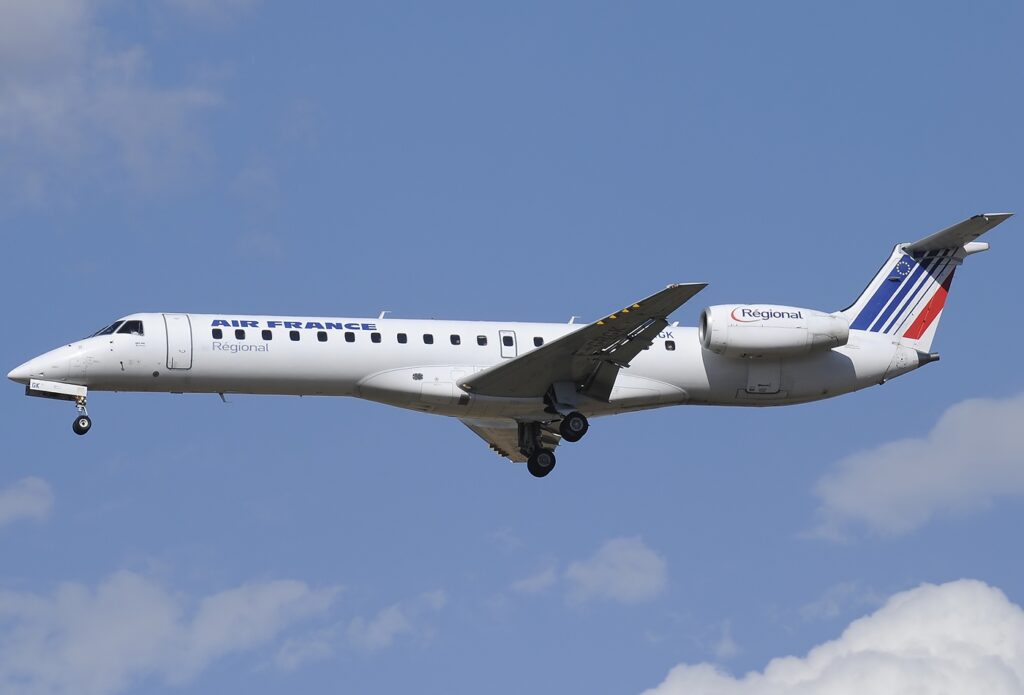
In the competitive world of regional aviation, the Embraer ERJ (Embraer Regional Jet) series has built a reputation for efficiency, reliability, and cost-effectiveness. Designed for short- to medium-haul operations, these jets have proven indispensable for airlines needing to connect smaller cities to major hubs without the overhead of larger aircraft.
With over 1,200 units delivered since its introduction in the late 1990s, the ERJ series remains a dependable workhorse in many regional airline fleets, especially in North America, Latin America, and Europe. One of the defining attributes that has contributed to its lasting appeal is its well-balanced range capabilities—offering enough distance to serve versatile regional networks while remaining economical to operate.
Overview of the ERJ Family: Three Models, One Mission
The Embraer ERJ series comprises three closely related variants, each tailored to slightly different market segments. Here’s a snapshot:
| Model | Seating Capacity | Max Range (nm) | Typical Use |
|---|---|---|---|
| ERJ 135 | Up to 37 passengers | ~1,750 nm (3,243 km) | Niche routes, low-demand markets |
| ERJ 140 | Up to 44 passengers | ~1,650 nm (3,056 km) | Medium-density regional routes |
| ERJ 145 | Up to 50 passengers | ~2,000 nm (3,704 km) | Long regional sectors, short international flights |
Each variant shares a common platform, which makes pilot training, maintenance, and operational logistics more efficient for airlines operating mixed ERJ fleets.
Detailed Range Capabilities of Each ERJ Variant
1. ERJ 135 – Compact and Nimble for Niche Markets
- Maximum Range: ~1,750 nautical miles
- Best Use Case: Ideal for underserved or low-demand routes, such as regional point-to-point service or thin feeder routes into major hubs.
- Operational Edge: Low fuel consumption and quick turnaround times make it a strong choice for airlines with high-frequency schedules.
Despite being the smallest in the family, the ERJ 135 punches above its weight in connectivity and agility, making it well-suited for secondary airports with limited demand.
2. ERJ 140 – The Balanced Mid-Size Performer
- Maximum Range: ~1,650 nautical miles
- Best Use Case: Bridges the gap between the 135 and 145, serving routes where more seats are needed but not quite at full 50-seat capacity.
- Operational Edge: Offers better economics per seat mile than the ERJ 135 while maintaining nearly identical performance specs.
The ERJ 140 was developed largely for fleet harmonization, especially for U.S. carriers needing to comply with scope clause restrictions (limits on aircraft size in regional operations).
3. ERJ 145 – The Flagship of the Series
- Maximum Range: ~2,000 nautical miles
- Best Use Case: Excellent for longer regional routes and short international connections, such as cross-border flights in Europe or the Americas.
- Operational Edge: Strong range and passenger capacity without the need for a larger narrow-body jet like the Airbus A319 or Boeing 737.
The ERJ 145 is often the first choice for regional carriers needing a longer reach without sacrificing efficiency, offering a rare blend of range and capacity for its class.
Factors That Affect Real-World Range Performance
While each ERJ model has a listed maximum range, actual operational range can vary depending on real-world conditions. Key influencers include:
- Passenger and Cargo Load: Heavier loads reduce overall range.
- Weather and Wind Conditions: Strong headwinds or poor weather routing can increase fuel burn.
- Topography and Route Profile: High-altitude or mountainous terrain may require more fuel.
- Airline Operating Procedures: Factors like required reserves, alternates, and flight planning policies can also impact usable range.
Understanding these variables is critical for airline route planners seeking to maximize efficiency without compromising safety or service quality.
Why ERJ Range Matters in Today’s Regional Aviation Landscape
In a world where ultra-long-haul jets often steal the headlines, the range of regional aircraft plays a more tactical role—connecting smaller communities, enabling economic development, and filling gaps that larger jets can’t profitably serve.
- Essential Connectivity: The ERJ’s range allows it to reach outlying cities, remote airports, and secondary markets.
- Fleet Efficiency: Airlines can right-size aircraft to match demand, avoiding the risk of flying half-empty narrow-bodies.
- Revenue Optimization: Airlines can explore more route combinations and increase frequency on popular sectors.
Simply put, the ERJ series offers the right range for the right mission, helping regional carriers remain profitable while offering passengers more travel options.
How the ERJ Series Compares to Competitors
While the Bombardier CRJ series and newer Embraer E-Jets (E170–E195) offer similar capabilities with improved fuel efficiency or passenger comfort, the ERJ series continues to hold its own:
| Jet Model | Typical Seats | Max Range (nm) | Highlight |
|---|---|---|---|
| ERJ 145 | 50 | 2,000 | Simple, reliable, low-cost |
| Bombardier CRJ200 | 50 | 1,700 | Competitive in early 2000s |
| Embraer E170 | 70 | 2,150 | Newer, more spacious |
| Mitsubishi SpaceJet (M90) | 88 | 2,300 | Still in development limbo |
The ERJ series remains a low-cost, low-maintenance option for carriers that prioritize operational simplicity and proven reliability over the latest tech.
Conclusion: The ERJ’s Range—A Strategic Asset for Regional Airlines
The Embraer ERJ series continues to be a backbone of regional aviation due to its well-balanced range capabilities, cost-efficiency, and operational flexibility. Whether it’s a short commuter hop or a regional cross-border mission, the ERJ offers the perfect mix of range and reliability.
For regional airlines, it’s more than just a jet—it’s a strategic enabler of network expansion, economic access, and passenger convenience. As global demand for regional connectivity continues to grow, the ERJ series is well-positioned to remain a go-to solution for years to come.

Leave a Reply